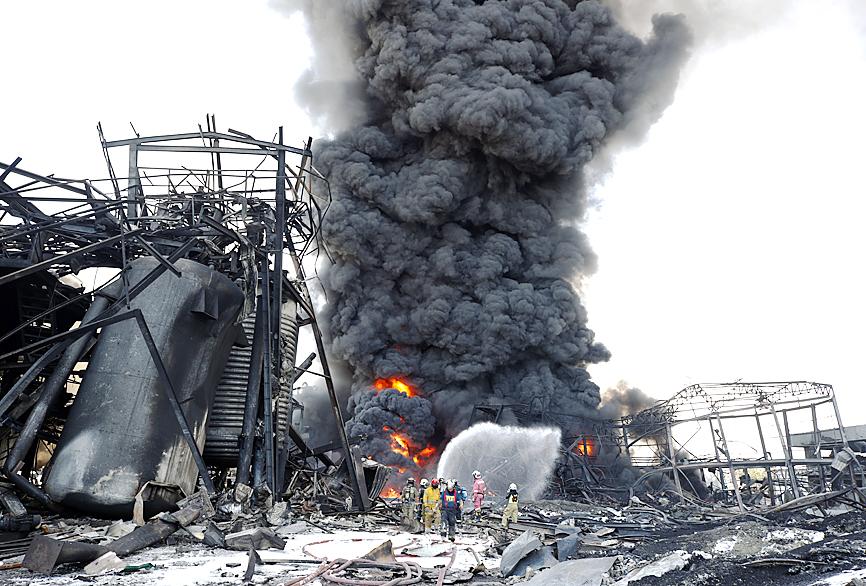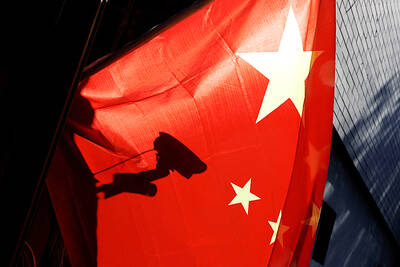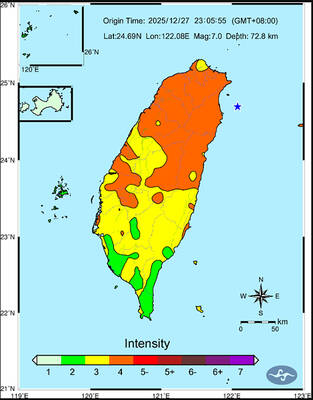A massive explosion at a Taiwanese firm’s chemical factory on the outskirts of Bangkok early yesterday killed at least one person, injured dozens more and damaged scores of homes, while prompting the evacuation of a wide area over fears of poisonous fumes and the possibility of additional detonations.
The fire broke out at about 3am at a foam and plastic pellet manufacturing factory just outside Bangkok near Suvarnabhumi Airport, with the explosion blowing out windows of surrounding homes and sending debris raining from the sky.
The explosion could be heard for kilometers and surveillance footage from a nearby house captured the bright flash and boom, followed by the damage to the property and the one next door from the shock waves.

Photo: EPA-EFE
The main blaze at the Ming Dih Chemical Co (明諦化學) factory had been brought under control by mid-morning, but an enormous tank containing the chemical styrene monomer continued to burn, disaster prevention official Chailit Suwannakitpong said.
Late in the afternoon, dense clouds of black smoke continued to billow from the site and helicopters tried to navigate close enough to dump fire retardant onto it, initially with little apparent success.
Authorities said 62 people had been injured, including 12 involved in the firefighting and rescue efforts, and one person had been confirmed killed.
Styrene monomer, a hazardous liquid chemical used in the production of disposable foam plates, cups and other products, can produce poisonous fumes when ignited.
Chailit said officials were trying to move everybody out of the area, including staff and patients from the neighborhood’s main hospital where many of the casualties were initially treated, over fears of poisonous fumes and the possibility of more explosions.
The chemical itself also emits styrene gas, a neurotoxin, which can immobilize people within minutes of inhalation and can be fatal at high concentrations.
Last year in Visakhapatnam, India, a leak of styrene gas from a chemical factory killed 12 people and sickened more than 1,000.
Authorities were carefully monitoring the air in the area and Thai Pollution Control Department official Thalerngsak Petchsuwan urged anyone remaining in the vicinity to close their doors and windows to avoid inhaling any fumes.
“Those who breathe it in can get dizzy and vomit, and it might cause cancer in the long term,” he said.
Jaruwan Chamsopa, who lives about 3km from the factory, said the loud explosion in the middle of the night broke her house’s windows, damaged the roof and caused parts of the ceiling to tumble down.
She said the windows of every house on her road were broken.
“I was shocked when the explosion took place,” she said. “I came out and saw a big fire in the sky.”
Chamsopa said that she, her husband and mother did not evacuate until 8am.
“I didn’t realize that it would be such a dangerous chemical that I have to evacuate,” she said. “I am worried because the black smoke reached my house.”
Authorities ordered the evacuation of an area 5km around the scene, and evacuation centers were set up in a school and a government office.
Volunteer rescue worker Anyawut Phoampai told TV station TPBS that early efforts to find people possibly still in the factory were hampered by the time it took to bring the fire under control.
“The flames are quite high so it takes quite an effort,” he said.
The initial explosion shook the terminal building at Suvarnabhumi Airport, setting off alarms.
Airport officials said in a statement that no flights had been canceled, but that it was continuing to monitor the situation and was prepared to “put in place contingency plans in case of emergency.”

A magnitude 7.0 earthquake struck off Yilan at 11:05pm yesterday, the Central Weather Administration (CWA) said. The epicenter was located at sea, about 32.3km east of Yilan County Hall, at a depth of 72.8km, CWA data showed There were no immediate reports of damage. The intensity of the quake, which gauges the actual effect of a seismic event, measured 4 in Yilan County area on Taiwan’s seven-tier intensity scale, the data showed. It measured 4 in other parts of eastern, northern and central Taiwan as well as Tainan, and 3 in Kaohsiung and Pingtung County, and 2 in Lienchiang and Penghu counties and 1

FOREIGN INTERFERENCE: Beijing would likely intensify public opinion warfare in next year’s local elections to prevent Lai from getting re-elected, the ‘Yomiuri Shimbun’ said Internal documents from a Chinese artificial intelligence (AI) company indicated that China has been using the technology to intervene in foreign elections, including propaganda targeting Taiwan’s local elections next year and presidential elections in 2028, a Japanese newspaper reported yesterday. The Institute of National Security of Vanderbilt University obtained nearly 400 pages of documents from GoLaxy, a company with ties to the Chinese government, and found evidence that it had apparently deployed sophisticated, AI-driven propaganda campaigns in Hong Kong and Taiwan to shape public opinion, the Yomiuri Shimbun reported. GoLaxy provides insights, situation analysis and public opinion-shaping technology by conducting network surveillance

‘POLITICAL GAME’: DPP lawmakers said the motion would not meet the legislative threshold needed, and accused the KMT and the TPP of trivializing the Constitution The Legislative Yuan yesterday approved a motion to initiate impeachment proceedings against President William Lai (賴清德), saying he had undermined Taiwan’s constitutional order and democracy. The motion was approved 61-50 by lawmakers from the main opposition Chinese Nationalist Party (KMT) and the smaller Taiwan People’s Party (TPP), who together hold a legislative majority. Under the motion, a roll call vote for impeachment would be held on May 19 next year, after various hearings are held and Lai is given the chance to defend himself. The move came after Lai on Monday last week did not promulgate an amendment passed by the legislature that

AFTERMATH: The Taipei City Government said it received 39 minor incident reports including gas leaks, water leaks and outages, and a damaged traffic signal A magnitude 7.0 earthquake struck off Taiwan’s northeastern coast late on Saturday, producing only two major aftershocks as of yesterday noon, the Central Weather Administration (CWA) said. The limited aftershocks contrast with last year’s major earthquake in Hualien County, as Saturday’s earthquake occurred at a greater depth in a subduction zone. Saturday’s earthquake struck at 11:05pm, with its hypocenter about 32.3km east of Yilan County Hall, at a depth of 72.8km. Shaking was felt in 17 administrative regions north of Tainan and in eastern Taiwan, reaching intensity level 4 on Taiwan’s seven-tier seismic scale, the CWA said. In Hualien, the